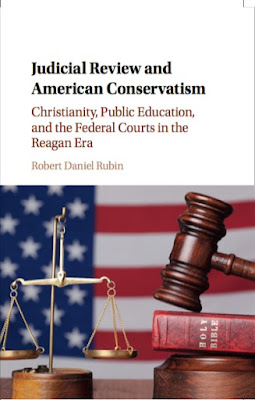In 2017, I published a book, Judicial Review and American Conservatism, with Cambridge
University Press, as part of its Law and Society in American History series. The book looks in particular at how the Christian Right of the 1980s in the United States forged a political identity as an aggrieved minority, in response to what it perceived as liberal judicial activism.
While
centering on events of the 1980s, the book considers popular opposition to the United
States court system during the tenures of Hugo Black, William Douglas, and
William Brennan. At no other point in American history did the federal courts
become so widely vilified. Many Americans objected to courts’ solicitude toward
unpopular minority groups, whose rights, many judges asserted, deserved
protection within a majoritarian political process inhospitable to minority
interests. Judicial review during these years was widely accused of posing a
“counter-majoritarian difficulty” within a system whose legitimacy rested with
purely democratic procedures.
Anti-judicial
animus pointed to a more general cultural strain. Since slavery, majority blocs
have castigated certain minority groups as innately un-American. During the
middle of the twentieth century, those groups included non-Christians,
atheists, non-whites, pacifists, socialists, hippies, and non–English speakers.
So-called “real Americans” have repeatedly drawn boundaries around the nation’s
supposed core and consigned others to society’s margins. When the Supreme Court
issued its landmark rulings on segregation, school prayer, freedom of speech,
and freedom of assembly, “real Americans” targeted the Court as the biggest
governmental threat to the nation’s cohesion. The significance of
antijudicialism is evinced in the presidential campaigns of George Wallace,
Richard Nixon, and Ronald Reagan, each of whom promised to nominate “strict
constructionist” judges. Such judges, it was implied, would protect the
prerogative of states such as Mississippi to pass laws of their own preference.
The trajectory of the twentieth century might thus be reversed, with state
legislatures no longer constrained by that pesky Bill of Rights.
During
the 1980s, a key shift occurred among lawmakers and lawyers. From the early
1960s through the early 1980s, opponents of the rights revolution championed
litigation and legislation aimed at reversing the Court’s decisions or
restricting its jurisdiction regarding matters such as school prayer. Beginning
in the early Eighties, the Christian right recognized the value of utilizing
rather than resisting the well-entrenched regime of civil-liberties
protections. Christian conservatives now claimed that they, too, constituted a
minority group whose rights to free speech and free religious exercise deserved
the same protections as those enjoyed by non-Christians.
My story
centers on two court cases and surrounding events in Mobile, Alabama, from 1981
through 1987. An atheist parent of schoolchildren sued the Mobile public
schools and the state for instituting daily prayers to be recited in the
classroom. Initially, local citizens responded by asserting the right of the
religious majority to encode its preferences into public policy. A federal
judge, W. Brevard Hand, agreed. In Jaffree
v. Mobile Board, he declared that the U.S. Supreme Court had long erred in
applying the First Amendment to the individual states.
My book contextualizes
the case amid machinations in the Reagan Justice Department, the U.S. Senate,
and the U.S. Supreme Court. There, longstanding majoritarian appeals to protect
school prayer were at this time losing their appeal, as proponents reconciled
themselves to the firm place of church-state separation in American law.
Defending the religious rights of Christians, and using the courts to do so,
were coming to seem more effective methods of guarding the place of religion in
the classroom.
After
the Supreme Court found against Alabama and the Mobile schools in Wallace v. Jaffree, it remanded the case
back to the trial judge. The case was then revived. In Smith v. Mobile Board, one of the original parties, a group of
evangelicals who had intervened in the case, was now named as plaintiffs. Its
mission was to rid state schools of textbooks that purportedly advanced the
“religion” of secular humanism, in violation of the First Amendment’s
proscription against an establishment of religion. The judge found for the
plaintiffs. If the Supreme Court insisted that he enforce the Establishment
Clause, then he would ensure that no “religion” at all were advanced in state
schools.
Smith was reversed on appealed,
and the long-term effectiveness of using the Establishment Clause to protect
religion in schools would prove limited. But the cases, and especially Judge
Hand’s opinion, would continue to inspire school-prayer advocates and alarm
opponents. Events in Mobile remain perhaps the clearest example, from the
1980s, of how a religious majority can advance its interests by using
constitutional protections customarily used by minorities. Writing this book
allows me, in the fairest, most objective way possible, to publicize these
important events.

2 comments:
Robert, I am very eager to read this book! Yasher koach on getting the contract and best of luck as you move toward the finish line!
Robert - Congratulations on your great accomplishments, academic and familial. I look forward to dropping into your blog. My very best wishes to Sarah, and Shana Tova to you and your family. Shalom, Richard
Post a Comment